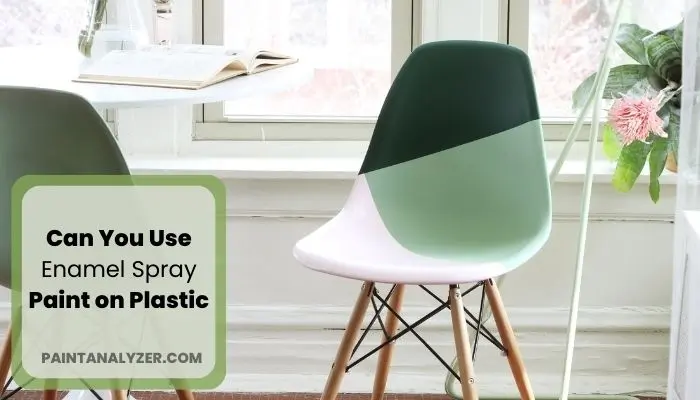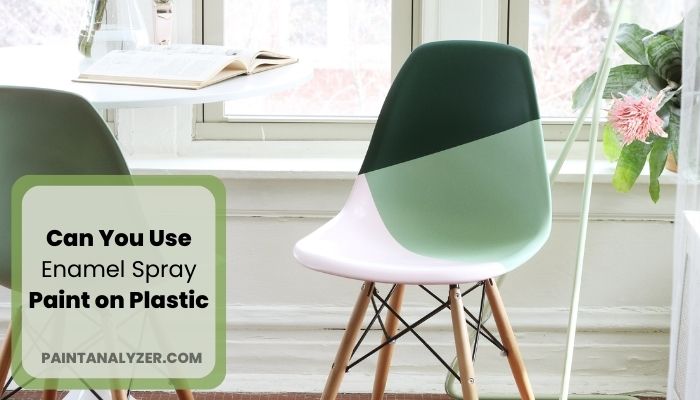It is no secret that plastic objects are everywhere in our homes. From children’s toys to storage containers, plastic is a material that is both versatile and affordable. But what if you want to give your plastic objects a new look? Can you use enamel spray paint on plastic?
The short answer is yes. You can use enamel spray paint on plastic. There are a few things you need to keep in mind in order to get the best results. Here, we will go over everything you need to know about painting plastic with enamel spray paint.

Which Spray Paint Will Adhere to Plastic?
Spray paint is a great way to add color and personality to any plastic surface. But not all spray paints are created equal. Some are specifically designed to adhere to plastic, while others will quickly peel or chip off.
If you’re looking for spray paint that will stick to plastic and provide a long-lasting finish, consider using a product that contains an adhesion promoter. They help the paint bond with the surface of the plastic, resulting in a stronger hold and more durable finish.
What are the best ways to Apply Enamel Paint to Plastic?
Enamel paint can be applied to plastic in a few different ways, depending on the type of paint and the desired finish. One way is to use a brush designed for enamel paints and apply it directly to the surface of the plastic. Another way is to thin the paint with a solvent such as mineral spirits or naphtha and then use an airbrush to apply it to the plastic.
If you are using enamel paint that is not specifically designed for plastics, you may need to add a primer before painting. This will help the paint adhere better to the surface of the plastic. You can also try sanding the surface of the plastic before painting, which will create a rougher surface for the paint to cling to.
How Can Enamel Paint Be Applied on Plastic? A step-by-step guide
Enamel paint is a great option for painting plastic surfaces. It is durable and long-lasting and can give your project a professional finish. Here is a step-by-step guide to painting plastic with enamel paint:
Step 1: Prepare the surface
Clean the surface of the plastic with soap and water. If the plastic is very dirty or greasy, you may need to use a degreaser or solvent to remove all of the dirt and grime. Once the surface is clean, sand it lightly with fine-grit sandpaper to roughen it up. This will help the paint to adhere to the plastic.
Step 2: Apply a primer
Once the surface is prepared, you will need to apply a primer. This will help the paint to adhere to the plastic and create a smooth surface. You can use either an aerosol primer or a brush-on primer. If you are using a brush-on primer, apply it with a small paintbrush and smooth it out as much as possible.
Step 3: Paint the surface
Now, you can start painting the surface with your enamel paint. Apply the paint in thin, even coats. If you are using a brush, use long, even strokes. When you are using spray paint, hold the can about 6 inches away from the surface and apply the paint in a light, even coat.
Step 4: Allow the paint to dry
When you have applied the paint, you will need to allow it to dry. This usually takes about 24 hours. Once the paint is dry, you can add any additional coats that you feel are necessary.
Step 5: Apply a clear coat
Once the paint is completely dry, you can apply a clear coat to protect the paint and give it a glossy finish. You can use either a brush-on clear coat or a spray-on clear coat. Apply the clear coat in the same way that you applied the paint.
Can Plastic Be Painted With Rustoleum Enamel Paint?
Yes, Rustoleum enamel paint can be used on plastic. It is a durable paint that will resist chipping and fading, and it adheres well to plastic surfaces. It is important to note that this paint is not compatible with all types of plastic.
For best results, consult the Rustoleum website or your local hardware store for guidance on which type of paint to use for your specific project.
What Are The Basics Of Painting Plastic? – HD
Can Wall Paint Be Used to Paint Plastic?
Painting plastic with wall paint is possible but not recommended. The reason being is that wall paint is not made to adhere well to plastic and will eventually peel off. Also, the fumes from the paint can be harmful to your health.
So, if you’re considering painting plastic, be sure to use a paint that is specifically made for plastic. And be sure to take proper safety precautions, such as wearing a mask to avoid inhaling fumes.
Is Enamel Spray Paint Suitable for Painting on Canvas?
Enamel spray paint is popular for many art projects, but it may not be ideal for spraying paint onto canvas. While it can provide a glossy finish, the texture and absorbency of canvas may not be compatible with this type of paint. It’s best to use acrylic or oil paints specifically formulated for canvas to ensure durability and longevity.
Is Acrylic Paint Safe to Use on Plastic?
It is possible to paint plastic with acrylic paint, but there are a few things to keep in mind. You must ensure that the surface is clean and grease or dirt-free. Otherwise, the paint will not adhere properly.
It is essential to use a primer specifically designed for plastic before painting; this will help the paint to better stick to the surface. When painting plastic, always use thin coats of paint and allow each coat to dry completely before applying the next one. With these tips in mind, you should be able to achieve good results when painting plastic with acrylic paint.
Conclusion
In conclusion, you can use enamel spray paint on plastic, but there are a few things you need to keep in mind. Make sure to clean the plastic surface before painting, and choose a paint that is specifically designed for plastic. Then, apply the paint in thin, even coats, and be sure to let it dry completely between each coat. Thank you for reading!

